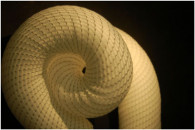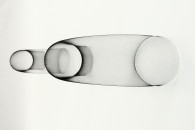
Biomedical textiles are one of the fastest growing segments in the textile industry, according to Dr. Martin King, professor of textiles at North Carolina State University (NCSU), and an expert in biotextiles. But what exactly are biomedical textiles? What’s driving development? And what are the benefits for materials manufacturers, device and product manufacturers and end users?
Defining the field
Biotextiles refer to textile-based devices that are implanted in the body, including devices such as arterial grafts, orthopedic attachment devices and heart valves. Medical textiles refer to textile products used for external applications, including products such as filtration masks, wound dressings, hospital linens and protective clothing. Together, biotextiles and medical textiles make up the biomedical textile field.
Mother Necessity

What’s driving the developments in the biomedical textile field is that which often spurs innovation: need. There is a need for products that not only protect patients from harm, but also stimulate healing.
For some innovators, the driving force behind product development is largely personal. A family member experiences a need the medical community cannot meet so the innovator sets out to develop a solution. This was the case for both David Horinek, the founder of Celliant, Santa Monica, Calif., who created a fiber enhanced by thermo-reactive minerals that recycles and converts radiant body heat into infrared energy; and David Gray, the founder of MedTextra™ fabrics, St. Paul, Minn., who developed a fabric system that creates a balance between moisture, airflow and virus-scale filtration. For others, the genesis comes from expertise in the field and identifying a market-specific need, as was the case for Robert Torgerson, president and founder of RxFiber LLC, Windsor, Calif., a company that produces material for implantable medical devices; and Tom Molz, the founder of US BioDesign, Quakertown, Pa., whose company designs, develops and manufacturers biomedical textile structures for medical device companies.
More oxygen, please
Celliant’s thermo-reactive technology converts the body’s energy into infrared energy that is reflected back to the wearer, resulting in increased TCPO2 (transcutaneous pressure of oxygen) levels. To date, the technology has been used primarily in the sports markets because of its ability to enhance performance by increasing tissue oxygen levels. Puma, Saucony and Adidas all offer products made with Celliant. But health and medical applications are an emerging market for the company as well, particularly for treating diabetes.
The National Diabetes Education Program shows that 5.8 million Americans have diabetes—8.3 percent of the U.S. population; and it estimates that 79 million adults aged 20 and older have prediabetes. “Unfortunately, the diabetic market is growing,” says Trenton Horinek, business development manager for Celliant. “The studies we’ve done on Celliant show an increase in TCPO2, which in laymen’s terms, is how much oxygen travels through your body, and reaches your skin. In diabetics, that level is sometimes very low, and it is why they often have cold hands, cold feet and neuropathy—resulting at times in amputations. By wearing garments made with Celliant the TCPO2 number increases by an average of 7 to 12 percent.”
Sleep can also be enhanced by increased TCPO2 levels, Horinek says. “We did pilot sleep studies at UC Irvine, California, that showed a decrease in nocturnal awakenings when the subjects slept on bedding manufactured with Celliant,” he says. “That means the subjects were in REM sleep longer, and woke up an average of 10 minutes earlier because the sleep they had was more restorative.”
The fibers that make up Celliant are embedded with 13 minerals, three of which are titanium dioxide, silicon dioxide and alumina oxide. The rest are part of the company’s proprietary formula. “The minerals are used for their thermal reactivity and are very efficient at absorbing and reflecting energy,” Horinek says.
Water capture
Superabsorbent polymers (SAP) form the basis for the MedTextra fabric system, a platform technology that captures water from the air to keep medical textiles moist. Applications include face masks, wound care for diabetic foot wounds, surface wiping technology and filtration systems. The products can be produced as woven and nonwoven fabrics using current production machinery and staple fibers and ingredients.
“SAP is part of a delivery system within the fiber,” Gray says. “It can absorb 500 times its weight in water. What it does for wound care, for example, is control the moisture level over the sore to whatever level you want, depending on the concentration of SAP in the fabric. If you want a higher concentration of moisture, you need a higher capacity SAP. Different wounds require different levels of ambient moisture for healing.”
What the system does for face masks is to provide a physical barrier that creates a breathing volume to regulate moisture as well as a platform to deliver active ingredients such as antimicrobials. “Humectants applied to the SAP pull moisture from breath. This creates an active microbial grasping surface that picks up, holds and kills microbes on the surface of the mask,” says Mark A. Litman, MedTextra’s patent attorney and a co-inventor. “The microbes in the fiber are deactivated without the risk of the antimicrobial compound drying out and the potentially harmful particles breathed in by the user. The strength of the antimicrobial activity can remain over sufficient time so that the mask can be reused and still retain its original level of performance.”
The company tested MedTextra fabric, comparing it to existing filtration systems on the market. “We tested MedTextra fabric at a 20 percent relative humidity, which is similar to a dry traditional filter,” says Clyde Hanson, marketing manager. “We then put it in a room overnight and raised the humidity to 50 percent, which saturated the SAP fibers with moisture. The difference increased filtration efficiency by 26 percent [over the dry traditional filter].”
Small and flexible
 Implantable devices for heart valves, endovascular stents, sutures and orthopedic attachments are not new—but advancements are being made in reduced size and increased flexibility of materials. “The ongoing focus of minimally invasive surgery is important [to what we’re developing],” says Keith Smith, director for business development for US BioDesign. “Textiles are unique. The nature of their flexible structure allows them to be compressed into a very small catheter to be delivered to the repair site and deployed back to full shape. That allows for very small incisions, which contributes to reduced trauma and quicker recovery for the patient.”
Implantable devices for heart valves, endovascular stents, sutures and orthopedic attachments are not new—but advancements are being made in reduced size and increased flexibility of materials. “The ongoing focus of minimally invasive surgery is important [to what we’re developing],” says Keith Smith, director for business development for US BioDesign. “Textiles are unique. The nature of their flexible structure allows them to be compressed into a very small catheter to be delivered to the repair site and deployed back to full shape. That allows for very small incisions, which contributes to reduced trauma and quicker recovery for the patient.”
Polymers can be absorbable (resorbable) and non-absorbable. The traditional non-absorbable polymers are polyesters and polypropylenes. Newer polymers include ultra-high molecular weight polyethylenes. Absorbables will do just that—break down and absorb into the body. Non-absorbables will stay where they’re implanted and elicit some tissue response from the surrounding tissue.
 Metal wires can be a part of a fabric structure. Titanium elicits a response from bone cells, while other metals are completely inert. Metal wire structures composed of nitinol, a nickel-titanium alloy, can be shape set into a particular shape prior to surgery, collapsed for delivery through a small incision and then deployed back to its full shape, enabling minimally invasive surgery. “Nitinol is a very important metal for textile structures in cardiovascular and neurovascular applications,” Smith says. “You can augment metal structures with polymer components if you want to put them in place, leave them there and elicit a tissue response. You can also use them to carry beneficial medicines to the site.”
Metal wires can be a part of a fabric structure. Titanium elicits a response from bone cells, while other metals are completely inert. Metal wire structures composed of nitinol, a nickel-titanium alloy, can be shape set into a particular shape prior to surgery, collapsed for delivery through a small incision and then deployed back to its full shape, enabling minimally invasive surgery. “Nitinol is a very important metal for textile structures in cardiovascular and neurovascular applications,” Smith says. “You can augment metal structures with polymer components if you want to put them in place, leave them there and elicit a tissue response. You can also use them to carry beneficial medicines to the site.”
Original endovascular surgical devices used DuPont® 4027 PET (polyethylene terephthalate), also known as Dacron®. While DuPont no longer allows it to be used for medical applications, equivalent material is available through RxFiber and is still used for applications such as stents, sutures and orthopedic devices. A new variation of the material comes from RxFiber. RxFibron™, the company’s first commercially released product, is an equivalent of the 4027 fiber, but is also available in custom sizes.
RxFibronHT™ is the company’s latest development, which was the result of the industry’s demand for lower profile, smaller, stronger fibers. “There were some complications with patients with smaller vasculatures,” Torgerson says. “Tearing of the vascular walls could result, either because of calcification reducing the lumen of the vessel, or the patient was simply anatomically smaller.”
The company is partnering with Dr. Martin King at NCSU and Dr. Chris Pastore at Philadelphia University to analyze and research a comparative analysis between RxFibronHT, standard RxFibron 4027 and UHMWPE (ultra-high molecular weight polyethylene). “Preliminary findings show that we had a 50 percent plus increase in tenacity in the yarns over the current polyester,” Torgerson says. “So now a part can be designed so it only requires two-thirds of the mass of fiber, which results in smaller devices.”
From scientific advancements to start-up business opportunities to consumer health benefits, biomedical textiles are on the forefront of the medical and research communities’ minds. As people live longer and have an expectation of health and wellness as they age, they will continue to look to textiles for improved medical solutions.
 TEXTILES.ORG
TEXTILES.ORG


